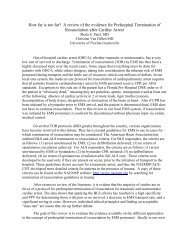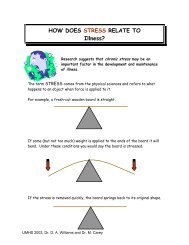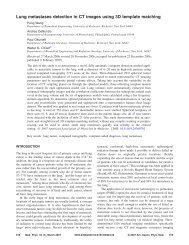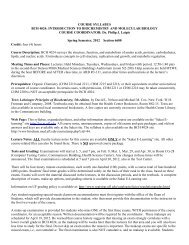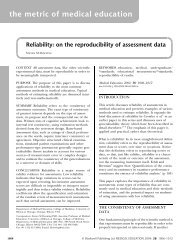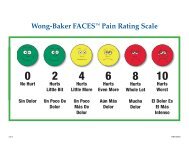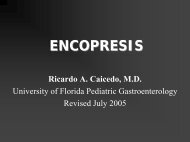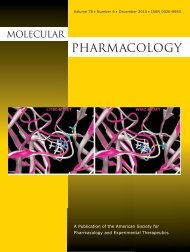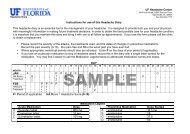imaging three-dimensional cardiac function - Walter G. O'Dell, PhD
imaging three-dimensional cardiac function - Walter G. O'Dell, PhD
imaging three-dimensional cardiac function - Walter G. O'Dell, PhD
You also want an ePaper? Increase the reach of your titles
YUMPU automatically turns print PDFs into web optimized ePapers that Google loves.
448 O’DELL MCCULLOCHAnnu. Rev. Biomed. Eng. 2000.2:431-456. Downloaded from arjournals.annualreviews.orgby UNIVERSITY OF ROCHESTER LIBRARY on 07/27/09. For personal use only.inotropic stimulation in at-risk regions of canine hearts subject to LAD occlusionand reperfusion. Regions of unchanged <strong>function</strong> after dobutamine infusionwere shown to correlate with areas of infarction as evidenced by TTC staining.?Hopefully, conclusive clinical test results will soon be forthcoming.MEASUREMENT OF THREE-DIMENSIONAL TISSUEARCHITECTUREThe heart has a complex 3-D anatomy that plays a significant role in the generationof 3-D wall deformation (93). There exists a predominant fiber directionthat is nearly completely confined to a circumferential-longitudinal plane, with anin-plane angle with respect to the heart long-axis that varies nearly linearly withwall depth. However, conflicting theories remain as to the tertiary structure of thefibers. The dissections and histological findings of LeGrice et al (94) suggest alaminar structure of the fiber bundles, with loose collagen connections betweenbundles of 4–5 fibrils. They found that the laminar or sheet arrangement is consistentamong canine subjects and hypothesized that the sheets facilitate largewall shears and increased wall thickening during contraction. A dilemma for anyanatomical study is that intervention distorts the underlying 3-D fiber structure,and, hence, conclusions about the intact structure are suspect. Yet, dissection andhistological sectioning remain the gold standards for elucidating the 3-D fiberarchitecture.Considerable data on fiber structure in canines have been presented by Streeter& Hanna (93) and LeGrice et al (94), but these findings do not necessarily applyto the human heart. Owing to difficulties in obtaining suitable human hearts andin performing the histological sectioning, detailed 3-D fiber structure analysis fora human heart has yet to be performed.A recent application of MR phase-sensitive <strong>imaging</strong> is now finding use formeasurement of myocardial fiber architecture. MR diffusion-sensitive <strong>imaging</strong>uses phase-contrast <strong>imaging</strong> techniques, but these are tailored to motions on thescale of free-water diffusion. The tissue sample is spatially marked by applyinga magnetic field gradient for a short period of time, creating a linear dispersionof the phase of the tissue magnetization across the sample along the direction ofthe applied gradient field. Nuclei that subsequently move will carry their phaseinformation to the new location. A refocusing gradient then resets the stationaryspins to their original phase state.In a population of nuclei, random motion that is parallel to the applied gradientfield will cause a dispersion of phase around the stationary-phase value and a correspondingdecrease in pixel intensity that varies exponentially with the square ofthe magnitude of the applied gradient (assuming that restricted diffusion effectscan be ignored). The coefficient of that exponential is the diffusion coefficient. Thelonger the average displacement of the population, the greater the spread in thephase, the greater the signal attenuation, and the larger the diffusion coefficient.



